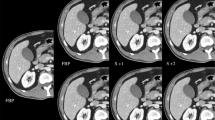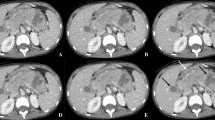Abstract
Objective
To compare image quality and radiation dose using Adaptive Statistical Iterative Reconstruction (ASiR) and Filtered Back Projection (FBP) in patients weighing ≥91 kg.
Methods
In this Institution Review Board-approved retrospective study, single-phase contrast-enhanced abdominopelvic CT examinations of 100 adults weighing ≥91 kg (mean body weight: 107.6 ± 17.4 kg range: 91–181.9 kg) with (1) ASiR and (2) FBP were reviewed by two readers in a blinded fashion for subjective measures of image quality (using a subjective standardized numerical scale and objective noise) and for radiation exposure. Imaging parameters and radiation dose results of the two techniques were compared within weight and BMI sub-categories.
Results
All examinations were found to be of adequate quality. Both subjective (mean = 1.4 ± 0.5 vs. 1.6 ± 0.6, P < 0.05) and objective noise (13.0 ± 3.2 vs.19.5 ± 5.7, P < 0.0001) were lower with ASiR. Average radiation dose reduction of 31.5 % was achieved using ASiR (mean CTDIvol. ASiR: 13.5 ± 7.3 mGy; FBP: 19.7 ± 9.0 mGy, P < 0.0001). Other measures of image quality were comparable between the two techniques. Trends for all parameters were similar in patients across weight and BMI sub-categories.
Conclusion
In obese individuals, abdominal CT images reconstructed using ASiR provide diagnostic images with reduced image noise at lower radiation dose.
Key Points
• CT images in obese adults are noisy, even with high radiation dose.
• Newer iterative reconstruction techniques have theoretical advantages in obese patients.
• Adaptive statistical iterative reconstruction should reduce image noise and radiation dose.
• This has been proven in abdominopelvic CT images of obese patients.




Similar content being viewed by others
References
Steinbrook R (2004) Surgery for severe obesity. N Engl J Med 350:1075–1079
Buckley O, Ward E, Ryan A, Colin W, Snow A, Torreggiani WC (2009) European obesity and the radiology department. What can we do to help? Eur Radiol 19:298–309
Santry HP, Gillen DL, Lauderdale DS (2005) Trends in bariatric surgical procedures. JAMA 294:1909–1917
Schindera ST, Nelson RC, Yoshizumi T et al (2009) Effect of automatic tube current modulation on radiation dose and image quality for low tube voltage multidetector row CT angiography: phantom study. Acad Radiol 16:997–1002
Marin D, Nelson RC, Schindera ST et al (2010) Low-tube-voltage, high-tube-current multidetector abdominal CT: improved image quality and decreased radiation dose with adaptive statistical iterative reconstruction algorithm – initial clinical experience. Radiology 254:145–153
Uppot RN, Sahani DV, Hahn PF, Kalra MK, Saini SS, Mueller PR (2006) Effect of obesity on image quality: fifteen year longitudinal study for evaluation of dictated radiology reports. Radiology 240:435–439
Goldman LW (2007) Principles of CT: radiation dose and image quality. J Nucl Med Technol 35:213–225
Schindera ST, Nelson RC, Toth TL, Nguyen GT, Toncheva GI, DeLong DM et al (2008) Effect of patient size on radiation dose for abdominal MDCT with automatic tube current modulation: phantom study. AJR Am J Roentgenol 190:W100–105
Razinia T, Saver JL, Liebeskind DS, Ali LK, Buck B, Ovbiagele B (2007) Body mass index and hospital discharge outcomes after ischemic stroke. Arch Neurol 64:388–391
Martino JL, Stapleton RD, Wang M, Day AG, Cahill NE, Dixon AE (2011) Extreme obesity and outcomes in critically Ill patients. Chest 140:1198–1206
Mancini JG, Raymundo EM, Lipkin M, Zilberman D, Yong D, Bañez LL et al (2010) Factors affecting patient radiation exposure during percutaneous nephrolithotomy. J Urol 184:2373–2377
Letsas KP, Siklódy CH, Korantzopoulos P, Weber R, Bürkle G, Mihas CC et al (2011) The impact of body mass index on the efficacy and safety of catheter ablation of atrial fibrillation. Int J Cardiol. doi:10.1016/j.ijcard.2011.06.092
Sousa PJ, Gonçalves PA, Marques H, Raposo L, Calé R, Brito J et al (2010) Radiation in cardiac CT: predictors of higher dose and its reduction over time. Rev Port Cardiol 29:1655–1665
Rundle RL (2002) U.S.'s obesity woes put a strain on hospitals in unexpected ways. Wall Street Journal Online Edition. online.wsj.com/article/0,,SB1020194636122710680.djm,00.html. Accessed November 30, 2006
Flegal KM, Carroll MD, Ogden CL, Curtin LR (2010) Prevalence and trends in obesity among US adults, 1999-2008. JAMA 303:235–241
Amis ES, Butler PF, Applegate KE, Birnbaum SB, Brateman LF, Hevezi JM et al (2007) White paper on radiation dose in medicine. J Am Coll Radiol 4:272–284
Frush DP, Applegate K (2004) Computed tomography and radiation: understanding the issues. J Am Coll Radiol 1:113–119
Schauer DA, Linton OW (2009) National council on radiation protection and measurements report shows substantial medical exposure increase. Radiology 253:293–296
Brenner DJ, Hall EJ (2007) Computed tomography – an increasing source of radiation exposure. N Engl J Med 357:2277–2284
Berrington de González A, Mahesh M, Kim KP, Bhargavan M, Lewis R, Mettler F et al (2009) Projected cancer risks from computed tomographic scans performed in the United States in 2007. Arch Intern Med 169:2071–2077
Mettler FA Jr, Bhargavan M, Faulkner K, Gilley DB, Gray JE, Ibbott GS et al (2009) Radiologic and nuclear medicine studies in the United States and worldwide: frequency, radiation dose, and comparison with other radiation sources - 1950-2007. Radiology 253:520–531
Schauer DA, Linton OW (2009) NCRP report no. 160, ionizing radiation exposure of the population of the united states, medical exposure – are we doing less with more, and is there a role for health physicists? Health Phys 97:1–5
Reid J, Gamberoni J, Dong F, Davros W (2010) Optimization of kVp and mAs for pediatric low-dose simulated abdominal CT: is it best to base parameter selection on object circumference? AJR Am J Roentgenol 195:1015–1020
Mulkens TH, Bellinck P, Baeyaert M, Ghysen D, Van Dijck X, Mussen E et al (2005) Use of an automatic exposure control mechanism for dose optimization in multi-detector row CT examinations: clinical evaluation. Radiology 237:213–223
Stiller W, Schwarzwaelder CB, Sommer CM, Veloza S, Radeleff BA, Kauczor HU (2011) Dual-energy, standard and low-kVp contrast-enhanced CT-cholangiography: A comparative analysis of image quality and radiation exposure. Eur J Radiol. doi:10.1016/j.ejrad.2011.03.030
Graser A, Wintersperger BJ, Suess C, Reiser MF, Becker CR (2006) Dose reduction and image quality in MDCT colonography using tube current modulation. AJR Am J Roentgenol 187:695–701
Poletti PA, Platon A, Rutschmann OT, Schmidlin FR, Iselin CE, Becker CD (2007) Low-dose versus standard-dose CT protocol in patients with clinically suspected renal colic. AJR Am J Roentgenol 188:927–933
Schindera ST, Nelson RC, Lee ER, Delong DM, Ngyen G, Toncheva G et al (2007) Abdominal multislice CT for obese patients: effect on image quality and radiation dose in a phantom study. Acad Radiol 14:486–494
Kalra MK, Maher MM, D'Souza RV, Rizzo S, Halpern EF, Blake MA et al (2005) Detection of urinary tract stones at low-radiation-dose CT with z-axis automatic tube current modulation: phantom and clinical studies. Radiology 235:523–529
Silva AC, Lawder HJ, Hara A, Kujak J, Pavlicek W et al (2010) Innovations in CT dose reduction strategy: application of the adaptive statistical iterative reconstruction algorithm. AJR Am J Roentgenol 194:191–199
McCollough CH, Bruesewitz MR, Kofler JM Jr (2006) CT dose reduction and dose management tools: overview of available options. Radiographics 26:503–512
McCollough CH, Primak AN, Braun N, Kofler J, Yu L, Christner J (2009) Strategies for reducing radiation dose in CT. Radiol Clin North Am 47:27–40
Cornfeld D, Israel G, Detroy E, Bokhari J, Mojibian H (2011) Impact of adaptive statistical iterative reconstruction (ASIR) on radiation dose and image quality in aortic dissection studies: a qualitative and quantitative analysis. AJR Am J Roentgenol 196:W336–340
Leipsic J, Labounty TM, Heilbron B, Min JK, Mancini GB, Lin FY et al (2010) Adaptive statistical iterative reconstruction: assessment of image noise and image quality in coronary CT angiography. AJR Am J Roentgenol 195:649–654
Kambadakone AR, Chaudhary NA, Desai GS, Nguyen DD, Kulkarni NM, Sahani DV (2011) Low-dose MDCT and CT enterography of patients with crohn disease: feasibility of adaptive statistical iterative reconstruction. AJR Am J Roentgenol 196:W743–752
Yanagawa M, Honda O, Yoshida S, Kikuyama A, Inoue A, Sumikawa H et al (2010) Adaptive statistical iterative reconstruction technique for pulmonary CT: image quality of the cadaveric lung on standard- and reduced-dose CT. Acad Radiol 17:1259–1266
Prakash P, Kalra MK, Kambadakone AK, Pien H, Hsieh J, Blake MA et al (2010) Reducing abdominal ct radiation dose with adaptive statistical iterative reconstruction technique. Invest Radiol 45:202–210
Flicek KT, Hara AK, Silva AC, Wu Q, Peter MB, Johnson CD (2010) Reducing the radiation dose for CT colonography using adaptive statistical iterative reconstruction: a pilot study. AJR Am J Roentgenol 195:126–131
Moscariello A, Takx RA, Schoepf UJ, Renker M, Zwerner PL, O'Brien TX et al (2011) Coronary CT angiography: image quality, diagnostic accuracy, and potential for radiation dose reduction using a novel iterative image reconstruction technique-comparison with traditional filtered back projection. Eur Radiol 21:2130–2138
Ghetti C, Ortenzia O, Serreli G (2011) CT iterative reconstruction in image space: a phantom study. Phys Med. doi:10.1016/j.ejmp.2011.03.003
Bittencourt MS, Schmidt B, Seltmann M, Muschiol G, Ropers D, Daniel WG et al (2011) Iterative reconstruction in image space (IRIS) in cardiac computed tomography: initial experience. Int J Cardiovasc Imaging 27:1081–1087
Pontana F, Duhamel A, Pagniez J, Flohr T, Faivre JB, Hachulla AL et al (2011) Chest computed tomography using iterative reconstruction vs filtered back projection (Part 2): image quality of low-dose CT examinations in 80 patients. Eur Radiol 21:636–643
Pontana F, Pagniez J, Flohr T, Faivre JB, Duhamel A, Remy J et al (2011) Chest computed tomography using iterative reconstruction vs filtered back projection (Part 1): evaluation of image noise reduction in 32 patients. Eur Radiol 21:627–635
Schindera ST, Diedrichsen L, Müller HC, Rusch O, Marin D, Schmidt B et al (2011) Iterative reconstruction algorithm for abdominal multidetector ct at different tube voltages: assessment of diagnostic accuracy, image quality, and radiation dose in a phantom study. Radiology 260:454–462
Halpern E, Mehta D, Read K, Levin D et al (2011) Iterative reconstruction technique provides noise reduction and improved image quality for coronary CT angiography. Scientific session 25 – Cardiopulmonary imaging: cardiac. AJR Am J Roentgenol 196:A81–A84, abstract 215
EUR 16262 EN (2011) Quality criteria for computed tomography. www.drs.dk/guidelines/ct/quality/Download.htm. Accessed 8 January 2011
Huda W, Ogden KM, Khorasani MR (2008) Converting dose-length product to effective dose at CT. Radiology 248:995–1003
Landis JR, Koch GG (1977) The measurement of observer agreement for categorical data. Biometrics 33:159–174
Goldman LW (2007) Principles of CT and CT technology. J Nucl Med Technol 35:115–128
Zhao J, Jin Y, Lu Y, Wang G (2009) Filtered backprojection algorithm for triple-source helical cone-beam CT. IEEE Trans Med Imaging 28:384–393
Lu Y, Katsevich A, Zhao J, Yu H, Wang G (2010) Fast exact/quasi-exact FBP algorithms for triple source helical cone-beam CT. IEEE Trans Med Imaging 29:756–770
Thibault JB, Sauer K, Bouman CA, Hsieh J (2007) A three-dimensional statistical approach to improved image quality for multislice helical CT. Med Phys 34:4526–4544
May MS, Wüst W, Brand M, Stahl C, Allmendinger T, Schmidt B et al (2011) Dose reduction in abdominal computed tomography: intraindividual comparison of image quality of full-dose standard and half-dose iterative reconstructions with dual-source computed tomography. Invest Radiol 46:465–470
Hara AK, Paden RG, Silva AC, Kujak JL, Lawder HJ, Pavlicek W (2009) Iterative reconstruction technique for reducing body radiation dose at CT: feasibility study. AJR Am J Roentgenol 193:764–771
Singh S, Kalra MK, Hsieh J, Licato PE, Do S, Pien HH et al (2010) Abdominal CT: comparison of adaptive statistical iterative and filtered back projection reconstruction techniques. Radiology 257:373–383
Haaga JR, Miraldi F, MacIntyre W, LiPuma JP, Bryan PJ, Wiesen E (1981) The effect of mAs variation upon computed tomography image quality as evaluated by in vivo and in vitro studies. Radiology 138:449–454
Israel GM, Cicchiello L, Brink J, Huda W et al (2010) Patient size and radiation exposure in thoracic, pelvic, and abdominal CT examinations performed with automatic exposure control. AJR Am J Roentgenol 195:1342–1346
Author information
Authors and Affiliations
Corresponding author
Rights and permissions
About this article
Cite this article
Desai, G.S., Uppot, R.N., Yu, E.W. et al. Impact of iterative reconstruction on image quality and radiation dose in multidetector CT of large body size adults. Eur Radiol 22, 1631–1640 (2012). https://doi.org/10.1007/s00330-012-2424-3
Received:
Revised:
Accepted:
Published:
Issue Date:
DOI: https://doi.org/10.1007/s00330-012-2424-3




